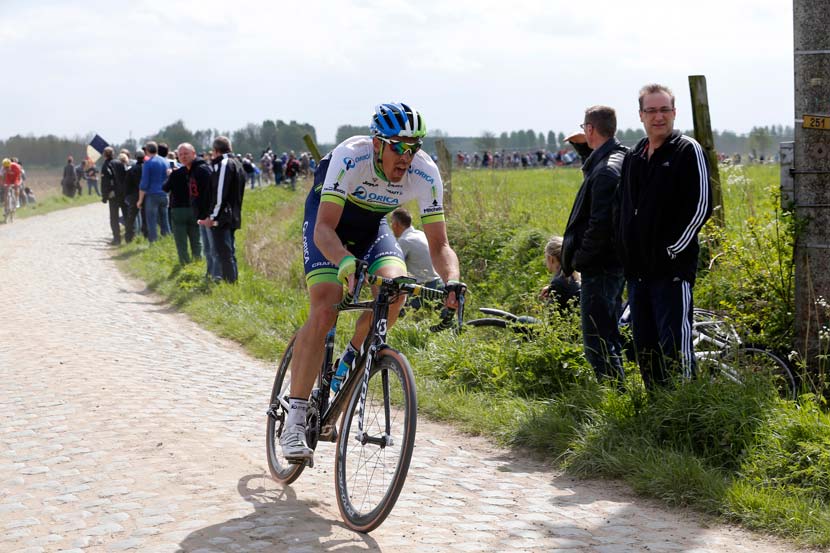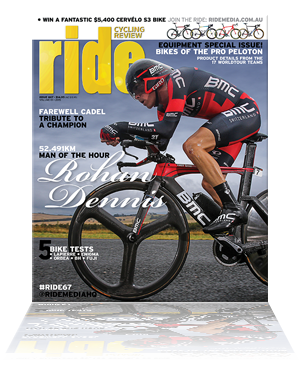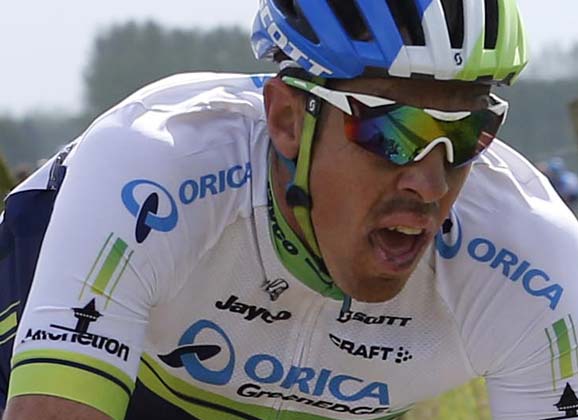In our chat with Mathew Hayman on the Thursday before Paris-Roubaix, the Australian veteran offered his thoughts on his previous race – Ronde van Vlaanderen – and then talked about what’s to come in the ‘Race to Hell’ that he loves so much. He speaks about Paris-Roubaix in detail offering an overview of the wattage required for riding over the cobbles of Arenberg, and explains his ‘big one’ tyre pressure for the pavé.

Mathew Hayman in Paris-Roubaix last year…
Photo: Yuzuru Sunada
* * * * *
To listen to part two of the interview, click the Soundcloud file and/or read the transcript below to see what Hayman has to say about Paris-Roubaix.
RIDE: We generally talk the week before or after Roubaix – or it seems to be a tradition of the last few years – so we understand your love of the race. We haven’t seen a hell of a lot of you this year. Have you been quietly preparing for Sunday? Do you still have that sense of anticipation that we spoke about last year?
Mathew Hayman: “Yeah, always for this race. Always. I’ve been waking up a bit through the night thinking about it. I feel like the form is there and I’ve prepared well for the season and prepared well for the Classics but I really only get four races this year on the cobbles.
“I did Milan-San Remo and chose not to ride Dwars door Flanders, that means that you’re just down to E3 [Harelbeke], Gent-Wevelgem, Flanders and Roubaix. I could go to [the Three days of] de Panne but I don’t think that fits in as the best preparation…
“I haven’t been sick or injured or anything so from October last year everything has been going well. So the form is there.
“Every year, it’s the Classics… if you’re good, you’re up there.
“Gent-Wevelgem was a strange race with the wind and I had a crash as well… I was top 20 there but I don’t think I really showed the form. And E3 as well – I felt like I was going really well and could have been in that chase group again for another top 10, top 15, but got caught behind a crash on the Patersberg. They’re just little things but I just seem to be missing out a bit on actually getting a result.
“I feel like I’m riding well and I just want to string it together and maybe on Sunday [in Flanders] I used too much energy trying to stay safe all day and not have any bad luck. And sometimes you have to gamble a little bit early in the race – if you don’t you’re constantly moving up and constantly staying in the front, to stay out of trouble you use a bit too much energy.
“There are some guys who are really good – like Van Avermaet or Jurgen Roelandts, those guys, they’re good at hiding themselves until the final arrives and then just racing… so I’m still learning, even at this stage, how to save energy and use it wisely.”
There are a lot of races where you can race according to power data. I don’t imagine that’s really relevant for Roubaix. Or is it?
“I think you can obviously analyse it and look at what’s needed to be there and I’ve got data from years to say what you need to be in the final, or near the final.”
What is that? What’s your average for that… that seven-hour bout? It must be a pretty strange chart.
“Ah, yeah I think it’s a lot shorter efforts than everybody thinks. There’s a lot of… someone was looking at it for me and you’ve got 100-130 of 30 second to one minute efforts and it’s about conserving those and using them when you need them. The other thing is to be able to, still after such a long race, get to or above threshold just after six-and-a-half hours. It’s not even massive amounts, you just run out of legs, so it’s about saving that energy so you can still [keep going].
“I don’t think the efforts change that much. It’s just the bombardment of them and if you can still go as fast on the last section as you were on the first section – then you’ll be there. But if you run out of legs, that’s it.”
And because it is flat, it’s a different reading isn’t it? It’s, like you say, 130 ‘sprints’…
“Yeah, controlled: 30 seconds, around that kind – or a minute – and that’s [when] moving up [in the bunch]. And a lot of that is placing yourself for the cobbles and then choosing which ones you need to be in the front for because it’s an effort to get there every time, and you’re sprinting against guys every single section. And then working out which ones are necessary and which ones aren’t…
“Getting through the big selection – the big Arenberg, you’ve got to get through there unscathed and use that energy there. Mons-en-Pévèle is pretty important. Once you get through there, you’re getting towards the final. And then, of course, you’ve got the Carrefour de l’Arbre and those ones towards the end there. That’s usually [when you’re] just holding on using everything up at the end.
“The race has gone before on section 13 or something. [Sector] ‘Marc Madiot’, which is after the second feed… sometimes the selection has gone there, so you’re already, with 60 or 70 km to go you can’t really afford to just wait.
“It’s not like Milan-San Remo where you can just sit back and conserve by just actually saving everything you’ve got until the Poggio and Cipressa. Yes, you have to conserve [in Paris-Roubaix] but you can’t miss anything at the same time.”
When you’re doing those [sectors], let’s say you’re going through Arenberg – which is a stretch of road a lot of people can relate to – is it more power to push over the cobbles? I’m interested in the wattage because people love to read about it but… or is it more a case of genuine bike handling, bike skill, that gets you through that section?
“No, it’s hard. It’s definitely hard.
“It’s also the effort of trying to place yourself in the front on the section before that. I think it’s the one that’s been on the internet a bit with the photos of the water, that’s the section before. So you kind of set yourself up for Arenberg by being near the front there because it always goes hard on that section.
“You get off there, have a little bit of recovery, and then you’ve got to do that sprint – that effort, the 30-second effort – getting into Arenberg.
“You have a little bit of recovery when it starts going downhill and then… yeah, it is a long slog. It’s a couple of kilometres long. And it’s hard. By the end, you’re above threshold. Maybe 450-500 watts for along that section. And yeah, there’s a little bit of technique but maybe you’re going quite hard.
“If you’re lucky enough to be up the front, it can ease off towards the end. People have already got their position and it’s too far out to be making a difference so it’s more about the safety, so it can ease off towards the end.
“I don’t know the exact figures for each [section of cobbles] but it’s close to 500 watts for me at my size and weight, which is not something you can hold for long. They’re all solid efforts, they’re like riding up a hill and it’s another thing to also try and keep your gears down especially early on in the day.”
Go at a high cadence, you mean?
“Yeah.
“People think Roubaix and big gears and that kind of thing but it’s often the case that you want to save your legs and I look at them as actually being almost like climbs. They are flat bits of road but the power is more similar to doing a small climb and you don’t want to be wasting your legs on every single one.
“We ride a big inside chainring – I think it’s a 46 or a 48 – and early on in the day I’ll try and make sure I’m in that every single time I hit the cobbles. And as soon as it slows down on the cobbles, I try and make sure I’m pedalling because otherwise it’ll just catch up with you.”
You started it, so I’ll get you to finish but can you just talk about the differences in bikes between even Flanders and Roubaix? You’ve got the big inside chainring [and]… what else?
“We’ve got the big inside chainring and we’ll run, I think, 26mm tyres. Or 28. It depends how people measure them. We go the biggest bag you can pretty much fit in the bike. Then it’s a toss-up whether you’re on the [Shimano] C50 or C35 wheels – that’s just the rider’s preference, the 35s have a bit more give in them. But the big one is actually the pressure: for each tyre it’s probably a bit different and the bag of the tyre can also make it a bit different. That’s another thing we’ll be testing tomorrow and that changes if it’s raining, it’s a different pressure again.
“Each manufacturer of the tyre will be different, slightly, so you just have to ride on them and see. But you’re not running much pressure: we’re talking between four and five-and-a-half, six bar.”
Which, in PSI is…?
“Ah, I’m not sure. I think we’re under 100 there.
“It’s about finding that medium there because you can definitely feel that on the road. If you’ve got a 26 – or essentially a 28mm tyres – and you’ve got 60 or 70psi in it, and there’s 100km before the first section of cobbles and the bunch is going along at 50 or 60km/h with attacks, and you’ve still got to ride that tyre to get there.
“You want to have enough pressure in so you’re not… so you don’t feel dead before you even get there.
“And there’s 60km of cobbles so that’s a fair whack and often you want to feel good on the cobbles at the same time.
“You’ve got to weigh that up – how much pressure [for comfort]? And also to minimise punctures. That’s a big one and something I’ve agonised over for years. It’s exactly why I’m getting out of the bus 10 times before the start to check and double-check and change… these days I just tell the mechanics, ‘Put whatever in. Don’t tell me. Just do it and I’ll ride it.’ Because, at the end of the day, it just does your head in.
“The big one, for me, is tyre pressure. The rest of it… handlebars I leave, some guys put double tape on, some guys are taping their fingers up – taping all their knuckles together – but I’ve not ever really gotten into anything like that.”
I know that there are a couple of big, exciting days ahead for you. I hope that you keep your adrenaline low until Sunday and then take advantage of the excitement that this race gives to you.
“Yeah, I mean there is a chance without Fabian [Cancellara] and Tom [Boonen] being there as guys who have the runs on the board – they’ve won it before and they know the feeling… and that’s hard to race against, a guy that knows how to win. Obviously Niki [Terpstra, the winner of Roubaix in 2014] will be racing again but it just makes it a little bit more open for everybody.
“I think our team – Jens [Keukeleire] and Mitch [Docker] – were in the final last year and we’ve definitely got a bunch of guys who love being there. ‘Durbo’ is just waiting to make a breakthrough performance in the Classics somewhere. He’s done well in de Panne a few years in a row but I think he really wants to have a go in one of these races…”
It’s his birthday today [Luke Durbridge turned 24 on Thursday] and someone said to me today, ‘He’s got to be the next big superstar in the Classics for Australia.’ Would you agree with that appraisal?
“Yeah. Yeah. I think he realises now that he definitely loves it and he has the physique for it and the power and he’s making steps – they’re not massive steps, he’s missing what the young Belgian guys have where they’ve done all these races a hundred times before. So I guess something like Roubaix is a bit more even for him… in Belgium it’s hard to rein that in if you didn’t grow up here and didn’t race here as an amateur, it takes a while to get that intimate knowledge of the course and he’s getting there. He’s just playing a bit of catch-up but the main thing is he likes being there.
“He loves being in the races and he’s passionate about it – otherwise you can’t spend time up in Belgium at this time of year.”
* * * * *
Part one: Hayman on the Ronde van Vlaanderen
* * * * *



